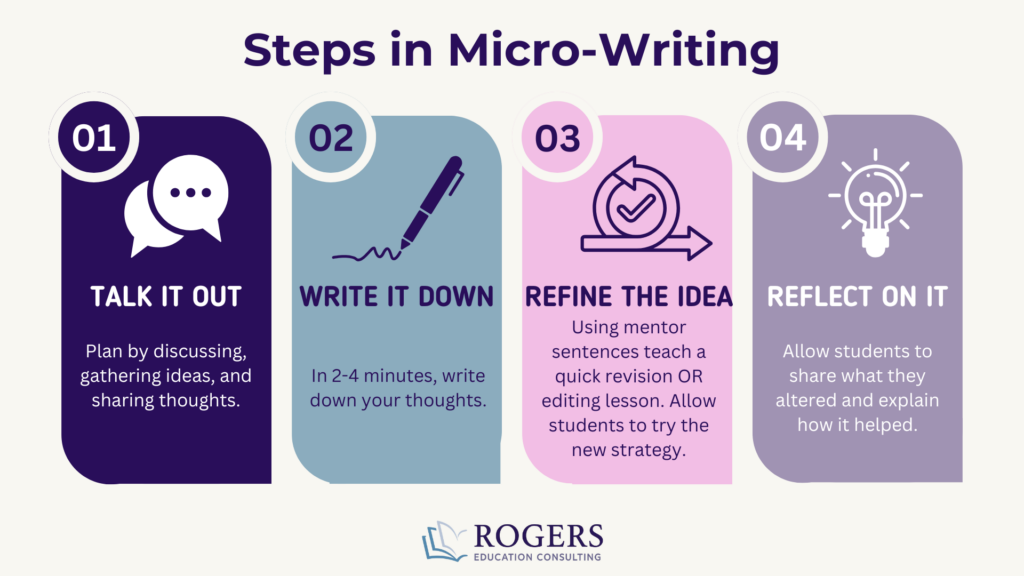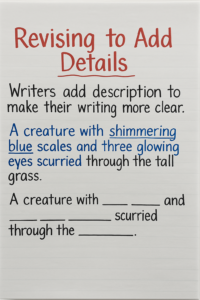📌 Why
A common writing frustration—“Getting students to add details is like pulling teeth!” If you’ve ever heard this in your classroom, you know how difficult it can be to help students move beyond basic writing to more descriptive, refined work.
✍️ Why It’s Important
Micro writing isn’t just about writing quickly, it’s about working through the entire writing process in a short burst. This approach gives students hands-on experience with the essential steps of writing—planning and revising—while keeping the task manageable. These two steps are the most cognitively demanding parts of the process, and by focusing on them in small, focused pieces, students are more likely to internalize these skills and improve their overall writing.
📚 Step-by-Step Breakdown
- Talk It Out: Start by having students verbally brainstorm their ideas. Give them a few minutes to discuss what they’re going to write about. This helps students organize their thoughts before putting them on paper. Encourage them to talk about their ideas, vocabulary, and the main points they want to convey. This process will lay the groundwork for their writing.
- Write It Down: Next, give students 2-4 minutes to write a short sentence or paragraph. The focus here isn’t perfection, but simply getting ideas onto the page. They can respond to a prompt like “Describe what the rain smells like” or something more personal, such as “What is your favorite memory from this past summer?” Remind them that this is just a starting point.
- Refine the Idea: Now, it’s time to revise. Pick one thing for students to improve—whether that’s adding more detail, sharpening their language, or making the sentence flow better. Students often avoid revision, but with micro writing, they only need to refine a small piece, making it more manageable. This could be as simple as adding a sensory detail to the sentence or changing one word to make the writing clearer.
- Reflect on It: After revision, give students time to reflect on their changes. How did the revision make their writing stronger? What’s different about the sentence now? Provide feedback during this phase, either one-on-one or as a group, so students can see the value of the revision process. Feedback should be quick, specific, and actionable.

🛠️ Differentiation
For differentiation, try using quarter sheets, sentence frames, or word banks to support students in the initial writing phase. Consider creating vocabulary word banks.
🚀 Scaffolding & Support
Struggling writers may need a bit more structure. To support them, allow verbal rewriting first—let students talk through their ideas, post important vocabulary, and discuss the topic. This verbal processing helps students connect their thoughts to language. Then, they can move on to the written part.
💡 Refine the Idea
A key element of micro writing is revision. But revision doesn’t need to be a daunting task, it’s simply refining one small piece of the writing. Often, students don’t revise enough because they only get to practice it on big projects. Micro writing offers low-stakes opportunities for frequent revision. Start small: maybe today, they’re focusing on adding description, tomorrow they’re layering in another detail.

🎓 Try It Tomorrow
Start small and make micro-writing a regular part of your classroom routine. Choose a skill to focus on—maybe it’s adding vivid descriptions to their sentences. Model how to do it, give students 2-4 minutes to write, and then ask them to revise it. Provide feedback quickly (this is the beauty of micro writing—it’s all about quick feedback loops). You’ll be amazed at how quickly students start to improve their writing, one sentence at a time.
About Micro Writing
Micro writing takes the writing process and condenses it into short bursts of practice. It gives students a chance to write, revise, and reflect without feeling overwhelmed. By focusing on one small piece of writing at a time, students not only get small writing wins but also receive quick, actionable feedback. Over time, these small wins add up, leading to stronger, more confident writers. Try micro writing today and watch your students’ writing transform!


